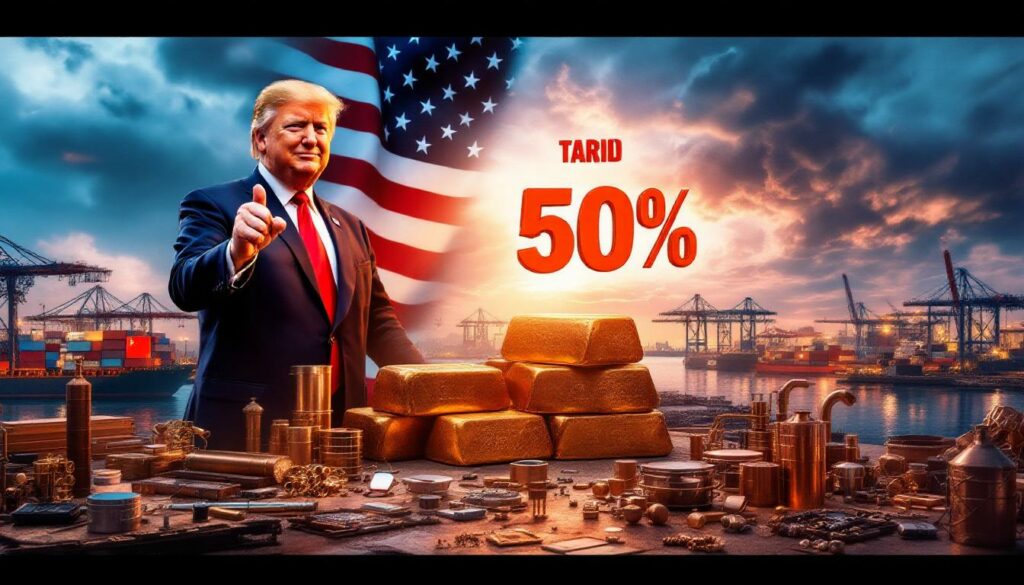What Does Trump's 50% Copper Tariff Include?
The Trump administration has announced a sweeping 50% tariff on copper imports, targeting a metal critical to America's infrastructure and technological future. Set to take effect on August 1, 2025, this tariff represents one of the most significant trade policy shifts in recent years for industrial metals.
Scope of the New Tariff
The 50% tariff will cover all refined copper imports entering the United States, according to Bloomberg News reporting from July 12, 2025. This includes not just pure copper cathodes but also semi-finished copper products that serve as inputs for American manufacturers.
Refined copper, defined as material processed to 99.9% purity or greater, represents the largest category of copper imported by the United States. This high-grade material forms the backbone of critical infrastructure including electric grids, telecommunications systems, and data centers.
While the measures remain subject to final formalization by the Trump administration, industry observers note that the announcement has already triggered significant market responses and supply chain planning adjustments.
Strategic Significance of Refined Copper
Copper's importance extends far beyond traditional applications, playing a crucial role in America's energy transition and technological leadership. As described by industry analysts, this metal serves as the "nervous system" of the modern economy.
The material is particularly critical for:
- Electric vehicle production – requiring up to three times more copper than conventional vehicles
- Renewable energy systems – with solar installations using substantial copper in wiring and components
- Data center construction – with each facility requiring thousands of pounds of copper
- Defense applications – including military hardware, communications systems, and naval vessels
The tariff decision signals Trump's broader effort to boost domestic production of essential materials while reducing dependence on foreign suppliers for strategically important resources, as evidenced by Trump's critical minerals order.
How Are Copper Markets Responding to the Tariff Announcement?
The announcement of Trump's 50% copper import tariff has sent immediate shockwaves through global metal markets, triggering price volatility and strategic recalculations throughout the supply chain.
Immediate Market Reactions
Copper prices jumped significantly following the announcement, as captured in Mining.com's market coverage from July 10, 2025. COMEX copper futures showed notable volatility as traders assessed the implications of such a substantial trade barrier.
Industry fears center around widespread economic ripple effects that could emerge from higher input costs. With copper functioning as a fundamental building block for manufacturing, construction, and technology sectors, price increases threaten to cascade through multiple industries.
The market disruption has also triggered concerns about potential stockpiling behavior ahead of the August 1 implementation date, which could further exacerbate price pressures and create artificial shortages. The uncertainty has prompted revised copper price prediction models from major financial institutions.
Industry Expert Perspectives
Robert Friedland, founder of Ivanhoe Mines and a respected voice in the mining sector, has publicly backed Trump's copper tariff, describing it as a "wake-up call" for American industry according to Mining.com reporting from July 11, 2025.
"This move is both obvious and intelligent for U.S. interests," Friedland stated. "America cannot continue to rely so heavily on foreign sources for such a critical material without creating serious vulnerabilities."
Industry analysts remain divided on the long-term market implications, with Benchmark Minerals Intelligence providing ongoing analysis of the tariff impact on copper prices. Some experts warn that the abrupt implementation could create supply bottlenecks, while others suggest it might accelerate much-needed investment in domestic copper processing capacity.
What Alternatives Has the Industry Proposed?
While the Trump administration has committed to the import tariff approach, significant segments of the copper industry have advocated for alternative strategies they believe would better serve American interests.
Industry Counterproposals
Hours after the tariff announcement, representatives from major copper industry players met with the White House Council of Economic Advisers to present alternative approaches. According to Bloomberg News reporting from July 12, 2025, these companies specifically requested scrap metal export controls instead of import tariffs.
The logic behind this counterproposal stems from America's position as a significant generator of copper scrap. The United States produces more metal scrap than its domestic consumption requires, with the excess typically exported to overseas markets. Industry representatives argue that keeping this valuable resource within U.S. borders would more effectively strengthen domestic supply chains than penalizing imports.
Key components of the industry alternative include:
- Restricting exports of copper ore and scrap rather than taxing imports
- Creating incentives for domestic processing of existing resources
- Establishing a graduated implementation timeline to allow supply chain adjustments
- Developing targeted exceptions for specific copper products with limited domestic alternatives
Key Industry Stakeholders Involved
Several major companies have taken leading roles in advocating for alternative approaches, including:
- Rio Tinto Group: A major mining company with significant copper operations globally
- Southwire Co.: One of America's largest copper fabricators, producing wire and cable products
- Trafigura Group: A global metal trader with extensive copper market expertise
These companies have expressed concerns that import tariffs could inadvertently harm American manufacturers by raising input costs while failing to address the fundamental challenges of domestic copper processing capacity.
Industry advocates argue that restricting exports of copper ore and scrap would provide a more balanced approach, keeping valuable resources within the United States while allowing time for domestic processing capacity to expand.
How Will the Tariff Impact U.S. Copper Supply Chains?
The implementation of a 50% tariff represents a seismic shift for U.S. copper supply chains, with potential consequences ranging from price inflation to critical material shortages.
Domestic Production Challenges
The United States currently relies heavily on imported refined copper, with domestic production capacity insufficient to meet current demand. This dependency creates significant vulnerabilities under the new tariff regime.
Several key challenges face domestic copper producers:
- Capacity constraints: Existing U.S. smelters and refineries operate at near-maximum capacity
- Infrastructure limitations: Expanding processing capabilities requires substantial capital investment
- Permitting hurdles: New facilities face lengthy environmental and regulatory approval processes
- Technical expertise gaps: Skilled labor shortages in specialized metallurgical roles
The time lag between tariff implementation and potential production increases creates a concerning transition period. Industry experts note that developing new copper refining capacity typically requires 3-5 years from planning to operation, creating a significant gap between policy implementation and domestic capacity response.
Supply Chain Disruption Scenarios
Multiple disruption scenarios loom as the tariff implementation date approaches:
- Price inflation: Downstream manufacturers face immediate cost increases for essential inputs
- Supply allocation challenges: Competition for limited domestic copper could disadvantage smaller manufacturers
- Project delays: Infrastructure initiatives may face timeline extensions due to material availability issues
- Substitution pressures: Manufacturers may seek alternative materials where technically feasible
Particularly concerning are complications for renewable energy and electrification initiatives that depend heavily on copper. Electric vehicle manufacturers, solar installation companies, and grid modernization projects all face potential cost increases and material availability challenges that could slow America's energy transition efforts.
"The copper supply chain isn't like turning on a tap. You can't just replace foreign supply with domestic production overnight. There's going to be a difficult transition period that affects real projects and real jobs." – Industry analyst comment from Mining.com video (July 10, 2025)
What Are the Global Implications of the Tariff?
Trump's 50% copper import tariff extends far beyond America's borders, promising to reshape global metal flows and trade relationships with significant copper-producing nations.
International Trade Relationships
The tariff announcement has immediate implications for major copper-exporting nations, particularly Chile, Peru, and China. These countries, which have historically supplied significant volumes of refined copper to the U.S. market, now face potential export disruptions.
The risk of retaliatory measures looms large, with copper-exporting nations potentially implementing their own trade barriers against American goods. Such escalation could trigger broader trade tensions beyond the metals sector, according to Reuters reporting.
The tariff also raises the likelihood of World Trade Organization challenges. Under GATT Article XI provisions, affected nations could file formal complaints arguing that the 50% tariff constitutes an unfair trade barrier.
Established global copper supply chains face unprecedented disruption, potentially leading to:
- Redirection of global copper flows to non-U.S. markets
- Price discrepancies between U.S. and international markets
- Development of alternative copper processing hubs
- Complex country-of-origin documentation to navigate tariff requirements
Environmental and Sustainability Considerations
The geographic shift in copper processing activities carries significant environmental implications. As processing potentially moves to regions with less stringent environmental standards, overall emissions related to copper production could increase.
Changes to scrap metal flows could impact recycling efficiencies globally. The United States has traditionally exported significant quantities of copper scrap, which supports circular economy initiatives worldwide. Disrupting these flows may reduce overall recycling rates and increase primary mining pressure.
The tariff could also accelerate new mining projects as companies seek to develop copper sources not subject to the tariff. This expansion may occur in regions with varying environmental standards and oversight mechanisms, potentially affecting the global copper supply forecast.
"We need to consider not just where copper is processed, but how. If production shifts to regions with weaker environmental protections, the net global impact could be negative despite potential U.S. manufacturing gains." – Environmental policy perspective from mining sustainability research
How Might This Affect Copper-Dependent Industries?
The ripple effects of Trump's 50% copper import tariff will be felt across numerous sectors, with particularly significant impacts on construction, technology, and renewable energy industries.
Construction and Infrastructure
The construction sector faces multiple challenges from the copper tariff implementation:
- Material cost increases: Copper wiring, plumbing, and components represent significant budget items in commercial and residential construction
- Project viability concerns: Affordable housing initiatives may face additional cost pressures, potentially reducing unit production
- Timeline extensions: Material procurement delays could extend construction schedules
- Value engineering pressures: Designers may seek to minimize copper usage where alternatives exist
Infrastructure renewal projects, many already operating on tight budgets, face particular challenges. Bridge replacements, road construction, and public works projects typically rely on competitive bidding processes that may not easily accommodate sudden material cost increases.
Technology and Renewable Energy
The technology sector's heavy reliance on copper creates particular vulnerability to the tariff's effects:
- Data center economics: Each major data center requires thousands of pounds of copper for power distribution and cooling systems
- Electric vehicle production: The average EV contains approximately 180 pounds of copper, roughly three times the amount in conventional vehicles
- Renewable energy installations: Solar farms and wind installations require substantial copper for generation and transmission components
These increased costs come at a critical time for America's clean energy transition. Solar and wind power installation economics already operate on narrow margins, and additional material costs could slow deployment rates.
Grid modernization efforts, essential for accommodating increasing renewable energy capacity, face similar challenges. The "smart grid" depends fundamentally on copper-intensive technologies for power distribution, monitoring, and control.
Table: Copper Requirements for Key Technologies
| Application | Copper Required | Impact of 50% Tariff |
|---|---|---|
| 1MW Data Center | ~5,600 lbs | Increased capital costs, potential deployment delays |
| Electric Vehicle (average) | ~180 lbs | Production cost increases, possible price adjustments |
| 1MW Solar Farm | ~9,000 lbs | Project economics challenges, delayed deployments |
| Wind Turbine (3MW) | ~4.7 tons | Cost increases, potential project cancellations |
| Single-Family Home | ~400 lbs | Construction cost increases, affordability impacts |
What Are the Economic and Political Motivations?
The 50% copper tariff aligns with broader "America First" manufacturing strategies while addressing perceived national security vulnerabilities in critical material supply chains.
America-First Manufacturing Strategy
The copper tariff represents a continuation of protectionist trade policies aimed at rebuilding domestic industrial capacity. This approach focuses on several key objectives:
- Domestic job creation: Encouraging expansion of U.S. mining, refining, and manufacturing operations
- Supply chain reshoring: Reducing dependency on foreign suppliers for critical inputs
- Industrial capacity rebuilding: Reversing decades of manufacturing capacity erosion
- Trade deficit reduction: Decreasing America's negative trade balance in industrial materials
The economic strategy emphasizes employment considerations in mining and manufacturing sectors, particularly in regions that have experienced industrial decline. Copper processing facilities tend to create stable, high-wage jobs in areas that have often seen economic challenges in recent decades.
National Security Considerations
The tariff announcement reflects growing concerns about America's dependency on foreign suppliers for materials deemed critical to national security.
Copper's classification as a strategically important material stems from its essential role in:
- Defense systems: Military hardware, communications equipment, and naval vessels
- Critical infrastructure: Power generation, transmission, and telecommunications networks
- Emergency response capabilities: Communications systems and essential services
- Technological sovereignty: Advanced manufacturing and strategic technologies
The focus on supply chain security reflects broader concerns about resilience in an era of increasing geopolitical competition. Control of critical minerals and processing capabilities has emerged as a key consideration in national security planning, particularly for materials with limited domestic production capacity.
"We cannot allow America's critical infrastructure to depend so heavily on foreign copper sources. This represents both an economic and security vulnerability that must be addressed." – Policy perspective from administration officials
FAQ About Trump's Copper Tariff
When will the copper tariff take effect?
The 50% tariff on copper imports is scheduled to begin on August 1, 2025, according to Bloomberg News reporting from July 12, 2025. However, the measures remain subject to final formalization and potential adjustments by the Trump administration before implementation.
Which copper products will be affected by the tariff?
The tariff will cover all refined copper as well as semi-finished copper products. Refined copper is defined as material processed to 99.9% purity or higher, which represents the largest category of copper imported by the United States. This includes products essential for electric grids, construction, automaking, and consumer electronics.
How have industry leaders responded to the tariff announcement?
Responses have been mixed among industry leaders. Robert Friedland, founder of Ivanhoe Mines, has publicly supported the move, describing it as a "wake-up call" and "intelligent" for U.S. interests, according to Mining.com reporting from July 11, 2025. However, major companies including Rio Tinto, Southwire, and Trafigura have proposed alternative approaches focused on export controls rather than import tariffs during meetings with the White House Council of Economic Advisers.
Will the tariff affect copper scrap exports from the U.S.?
The tariff announcement primarily focuses on imports rather than exports. Industry representatives have specifically requested that the administration not implement export controls on copper scrap, as the U.S. generates more scrap than it consumes domestically and typically exports the excess. Industry proposals have suggested that restricting ore and scrap exports could be more effective than import tariffs in strengthening domestic supply chains.
What potential economic impacts might result from the tariff?
Economic impacts could include higher prices for copper-dependent industries, supply chain disruptions during the transition period, increased manufacturing costs for products ranging from electronics to construction materials, and possible retaliatory trade measures from copper-exporting countries. The tariff may also accelerate copper investment trends in domestic processing capacity, though such expansion typically requires several years to implement.
Further Exploration
Trump's 50% copper import tariff represents a fundamental shift in U.S. trade policy for critical minerals, with far-reaching implications for global supply chains, domestic manufacturing, and America's energy transition. As implementation approaches, both proponents and critics will be closely monitoring market responses and industry adaptations to this significant policy change.
The coming months will reveal whether this tariff achieves its stated goals of rebuilding domestic processing capacity and reducing foreign dependency, or whether the disruptions to established supply chains create unforeseen challenges for American manufacturers and consumers.
For stakeholders across affected industries, developing contingency plans, evaluating material sourcing options, and engaging with policymakers will be essential as this major trade policy shift unfolds.
Ready to Spot the Next Major Mining Opportunity?
Discover significant ASX mineral discoveries the moment they happen with Discovery Alert's proprietary Discovery IQ model, turning complex data into actionable investment insights. Explore historic examples of exceptional returns on our dedicated discoveries page and position yourself ahead of the market.




